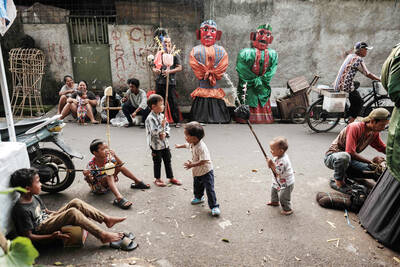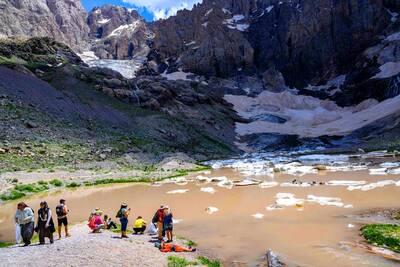Mexico’s drug violence has invaded the heart of one of its most famous beach resorts, with six people shot to death and five wounded during a raging gunbattle on the main boulevard in Acapulco’s tourist zone.
No tourists were among the casualties, but the shooting killed at least three bystanders and occurred in broad daylight on the wide, palm-lined avenue within sight of major hotels and the beach.
Drug gangs have staged shootouts in the city before, but seldom in broad daylight amid heavy traffic and never with such a toll among uninvolved people.
Desperate motorists crashed their cars and apparently sought to drive over the median strip to escape the gunfire, which left at least a dozen vehicles riddled with bullet holes.
A mother and her eight-year-old child, a taxi driver and a federal police officer were among the dead, while two slain men may have been the targets of the gunmen who set off the carnage, authorities said.
Five more people suffered wounds, but there was no information on their condition.
Federal police said they detained a 26-year-old and said he apparently worked for Edgar Valdez Villarreal, a US-born drug capo who has been engaged in a bloody battle in the Acapulco area with former colleagues in the Beltran-Leyva drug cartel.
Police said the gunbattle started when “armed men traveling in several vehicles opened fire on the occupants of another vehicle,” killing both men.
It was unclear why the men were targeted.
Police tried to intercept the gunmen’s vehicles.
“In their attempt to escape, the assailants opened fire on several private vehicles, killing three people, including a child,” federal police said in a statement.
City police said the eight-year-old girl died while being transported in an ambulance and her mother was killed. A policeman at the scene said the mother had apparently just picked her daughter up from school when they were caught in the hail of bullets.
While police officers may have tried to return fire, the area was littered with hundreds of shell casings from AK-47 assault rifles — a weapon used almost exclusively by Mexico’s drug cartels.
The battle caused a huge traffic jam on the busy Miguel Aleman Boulevard. The intersection where the shooting occurred marks the start of a strip where high-rise hotels alternate with open expanses of beach and is among the city’s most heavily traveled and best known areas.
Drug violence has killed more than 22,700 people in Mexico since December 2006, but it has seldom touched the beach resorts and colonial cities favored by international visitors.
Acapulco, famous as an international getaway in the 1950s and 1960s, has become mainly a destination for Mexican tourists in recent decades.
The shooting came as Mexico’s tourism industry gradually recovers from a very grim period last year.
Tourism all but came to a halt last April as fear over the swine flu epidemic virtually paralyzed Mexico, forcing the closure of schools, restaurants and archeological sites.
Air travel to Mexico from some countries was also restricted.
Mexico’s revenue from foreign tourism dropped to US$11.3 billion, a 15 percent decrease from US$13.3 billion in 2008, Tourism Department data showed.
The department also blamed the worldwide economic downturn as another factor.
In other violence, the Mexican army announced on Wednesday that two soldiers and two gunmen died in a shootout in a northern Mexico area that has seen a recent spike in drug violence.
The army said soldiers patrolling in the border state of Nuevo Leon on Tuesday gave chase to six suspicious cars that crossed into neighboring Tamaulipas State, where a gunbattle ensued in the town of Comales.
An army statement said the fight also wounded three soldiers and several gunmen.
It said 200 soldiers and two helicopters had been deployed to the area to attempt to locate the assailants.
The northeastern states of Tamaulipas and Nuevo Leon, across from Texas, have seen a surge of violence in recent weeks that authorities blame on a fight between the Gulf cartel and the Zetas.

In the sweltering streets of Jakarta, buskers carry towering, hollow puppets and pass around a bucket for donations. Now, they fear becoming outlaws. City authorities said they would crack down on use of the sacred ondel-ondel puppets, which can stand as tall as a truck, and they are drafting legislation to remove what they view as a street nuisance. Performances featuring the puppets — originally used by Jakarta’s Betawi people to ward off evil spirits — would be allowed only at set events. The ban could leave many ondel-ondel buskers in Jakarta jobless. “I am confused and anxious. I fear getting raided or even

Kemal Ozdemir looked up at the bare peaks of Mount Cilo in Turkey’s Kurdish majority southeast. “There were glaciers 10 years ago,” he recalled under a cloudless sky. A mountain guide for 15 years, Ozdemir then turned toward the torrent carrying dozens of blocks of ice below a slope covered with grass and rocks — a sign of glacier loss being exacerbated by global warming. “You can see that there are quite a few pieces of glacier in the water right now ... the reason why the waterfalls flow lushly actually shows us how fast the ice is melting,” he said.

Eleven people, including a former minister, were arrested in Serbia on Friday over a train station disaster in which 16 people died. The concrete canopy of the newly renovated station in the northern city of Novi Sad collapsed on Nov. 1, 2024 in a disaster widely blamed on corruption and poor oversight. It sparked a wave of student-led protests and led to the resignation of then-Serbian prime minister Milos Vucevic and the fall of his government. The public prosecutor’s office in Novi Sad opened an investigation into the accident and deaths. In February, the public prosecutor’s office for organized crime opened another probe into

RISING RACISM: A Japanese group called on China to assure safety in the country, while the Chinese embassy in Tokyo urged action against a ‘surge in xenophobia’ A Japanese woman living in China was attacked and injured by a man in a subway station in Suzhou, China, Japanese media said, hours after two Chinese men were seriously injured in violence in Tokyo. The attacks on Thursday raised concern about xenophobic sentiment in China and Japan that have been blamed for assaults in both countries. It was the third attack involving Japanese living in China since last year. In the two previous cases in China, Chinese authorities have insisted they were isolated incidents. Japanese broadcaster NHK did not identify the woman injured in Suzhou by name, but, citing the Japanese